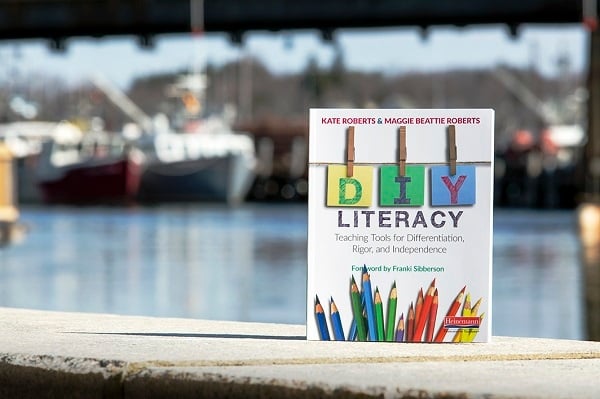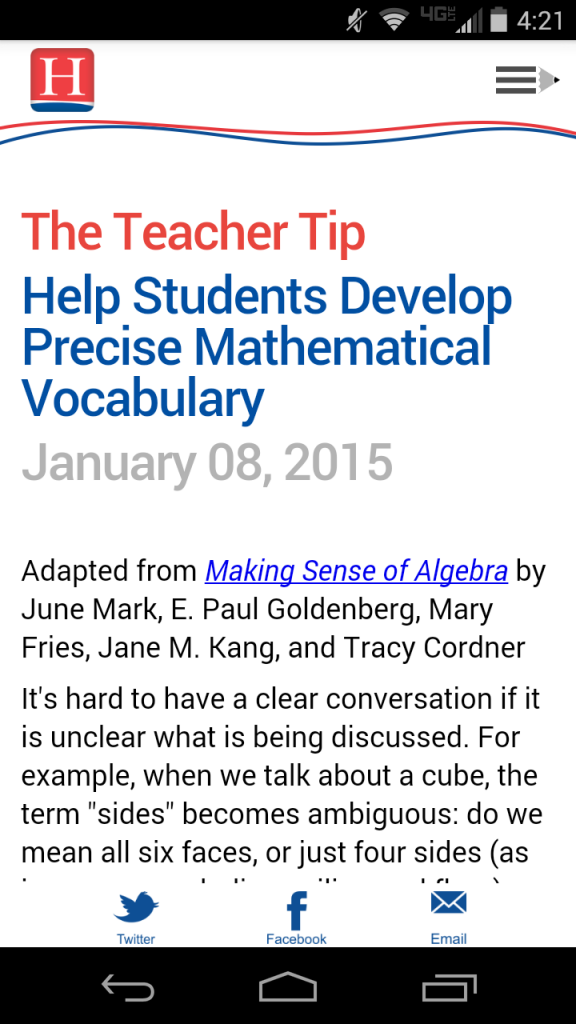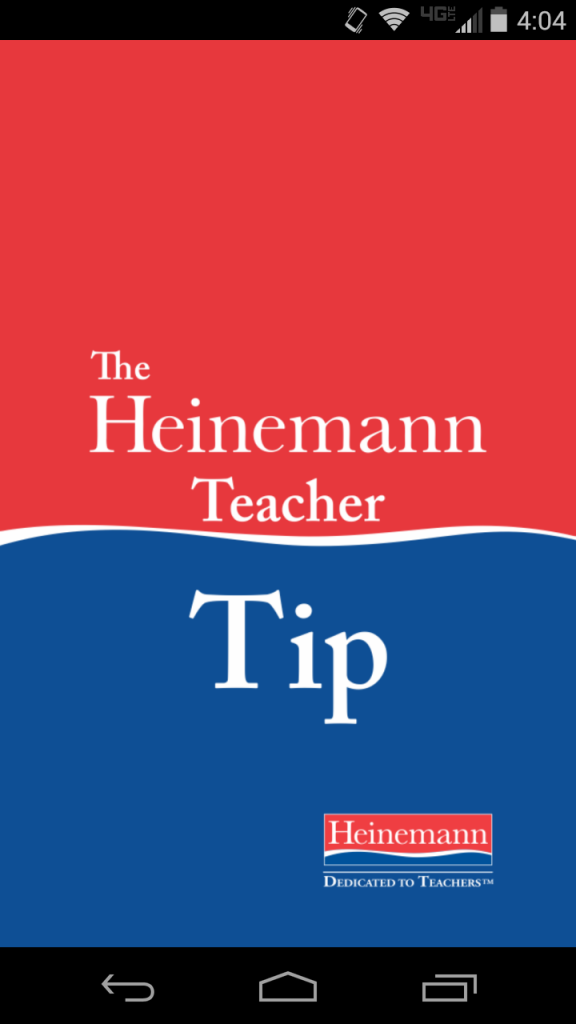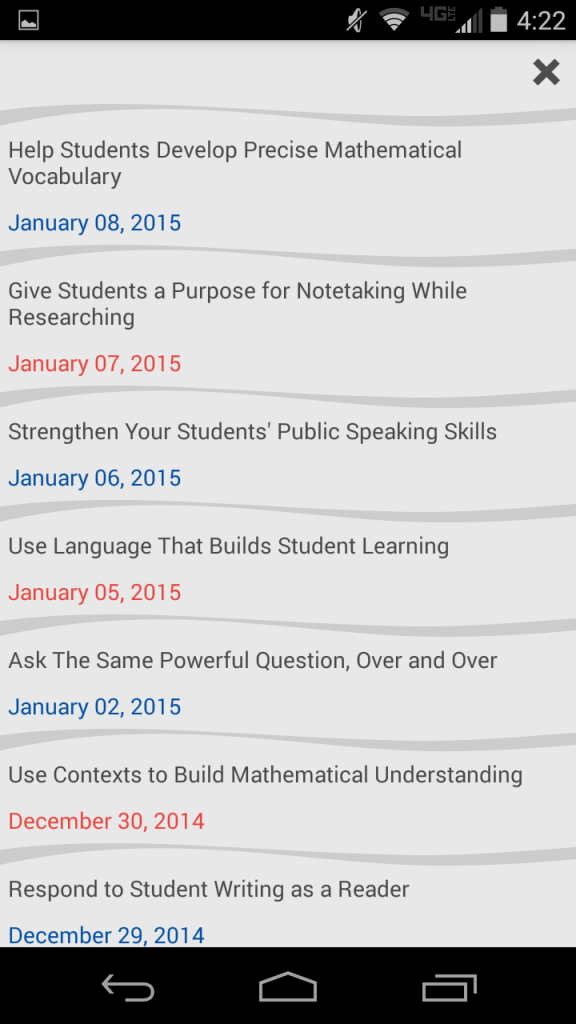
The Heinemann Teacher Tip App is available as a free download for iOS and Android devices. This app delivers ideas and inspiration from our authors directly to you every weekday. Sharpen your practice and share with colleagues for professional development in your pocket, on the go, forever.
Thousands of people share the daily teacher tip through Facebook, Twitter, and email. The App grows each season with Heinemann's newest offerings. Below, check out some of the more popular tips from recent and forthcoming titles. Here's what you're missing!

Teaching The Use Of "If... Then" Details
From The Big Book of Details by Rozlyn Linder
"If...Then" Details are sentences that suggest a relationship between two events, ideas, or concepts. While using the if/then structure implies that there is a cause and effect relationships, the If ... Then move may be a little slipperier than that. While this move can be used in narrative writing, it’s most common in arguments and informational texts. Writers use this move to help lead readers from an idea they can likely get on board with to an assertion that may be new to them or that they may not already believe or agree with.
Try this:
- Write the name of two familiar or recently-read books on the board or chart. Lead a conversation about each book by inviting students to share memorable scenes, favorite parts, or even criticisms of each book. Then, ask students to consider who else would enjoy these books. Then, craft a If…Then sentences for each book. Point out the similar structure to students, then ask students to write down the names of their favorite television shows, sports team, and book or author and repeat your process. Call on volunteers to share their sentences and tell about which type of audience they are trying to convince.
- Send students to the media center or your classroom library. Encourage them to look for books that they have read before and loved. When they find a favorite, ask them to think about what type of audience they think the book would be great for. Have students use the If…Then move to craft a sentence that convinces the audience to read the book. Turn the If…Then sentences into a book recommendation wall by adding the sticky notes to a door, wall, or cabinet surrounded by a label that says “Our Book Recommendations.”
- Select debate topics and ask students to choose sides. Group students with their respective sides and have students try to convince you to agree with their side. The only caveat? Their entire argument can only be made up of If...Then sentences. When they finish sharing their ideas, talk about how this move is convincing, but obviously cannot be your only type or detail. Lead students to the notion that using this move too much, starts to feel disingenuous and empty. This will help students to avoid heavy-handed use of this move when they craft their own arguments.
- Walk around the room pretending to talk on your cell phone and accidentally bump into chairs, tables, file cabinets, etc. Invite students to craft sentences, using the If...Then move to explain what they saw. Share the sentences in small groups or with the whole class. Repeat by acting out multiple scenarios. Fun scenes to act out: take a big sip of water and immediately start to cough uncontrollably and tap your neck or chest; fill a snack size plastic bag with lots of objects, until it breaks and the objects fall out; or write a very sloppy, almost illegible sentence on the board very quickly. After each scene, invite students to suggest If…Then sentences to explain what they saw. Record these on a large anchor chart to reference later.
Our chart captured the student examples and generated lots of discussion about the power of If…Then sentences, but it also reinforced the idea that these sentences aren’t based on fact, they are simply predictions and inferences, but they seem to lead the reader to the notion that they should accept the relationships as valid and factual.
The Big Book of Details is available now.

Mixing Up Teaching Tools: Variety Is the Spice of Life
From DIY Literacy by Kate Roberts and Maggie Beattie Roberts
People in retail and sales say that one of the keys to successful sales is making sure an item is rotated around a brick-and-mortar store from time to time. It’s a magic trick of sales—leave a shelf of Chia pets alone for too long and they won’t sell. But rotate them around the store and the products will move.
Perhaps this is due to people falling into patterns as they shop, not seeing the newness when immersed in a totally familiar landscape. Or maybe there is something more mystical involved, some kind of energy around objects that shine brighter when attended to. Whatever the cause, the result is the same: if we want people to notice things, we have to change them up.
In your classroom, if you leave a chart or a micro-progression up all year long in the same place, it’s likely that students will stop noticing it hanging there. It becomes background noise that is vague, indistinct, and uninteresting.
Here are a few ways to maintain the energy of the space and keep the tools fresh and useful:
- Consider the layout of your room as you plan an upcoming unit. Are there any charts you could move to the front that would be helpful? Could you switch where you hang your charts for different subjects or purposes?
- If there is a tool that you will be using often with your class, consider making a new and improved version from time to time. Even if it is an exact replica of the old one, a fresh coat of marker can help make it pop.
- Be sure to point to, reference, and generally make a big deal of any teaching tool you want the class to keep noticing. If we keep the tools alive, students will too.
While these tips are focused generally on the tools that get hung up on the classroom walls, such as charts and micro-progressions, the same theory can apply to other teaching tools. This kind of “upkeep” helps assure that your teaching tools feel fresh and useful.
DIY Literacy is available now.

Making Books to Teach the Writer
From More About the Authors by Lisa Cleaveland.
The idea that we need to “teach the writer, not the writing “ has been spoken and written about so many times now, it's easy to forget the important message of those words. What does it really mean to do this? How does planning a unit of study look different if we aim to teach the writer, not the writing? How does conferring sound different? How do we ask students to work at their writing when we aim to teach the writer, not the writing? How do we ask them to share with other children? I believe a focus on teaching writers instead of writing impacts every single decision I make about my teaching, and nowhere is that more clear than in the role that mentors play in that teaching. In my classroom, authors and illustrators are mentors, not texts.
Try making books in your classroom because making books:
- is developmentally appropriate.
- helps children do bigger work.
- helps children live like writers all the time.
- helps students read like writers.
Children learn indirectly from their mentors because they are reading like writers and illustrators. As the teacher, the “like “ part is all on me because I'm in charge of what children are asked to do in my class. When you think about it this way, some of the simplest decisions make such a difference. The first paper we use is blank paper because people who make picture books don't use lined paper. We use color because other picture book makers—like us—use color. We spend a long time on our covers because covers are a big deal to other picture book makers. The “like “ part of reading like writers depends on all this, and the like part is what leads to so much indirect learning that I just don't believe happens when the focus is on texts instead of the people who make them.
More About the Authors: Authors and Illustrators Mentor Our Youngest Writers is available now.
♦ ♦ ♦ ♦
More tips, delivered every weekday morning to your mobile device, are available on the official Heinemann Teacher Tip App!
The Heinemann Teacher Tip App features:
- Daily suggestions from leading practitioners you admire and trust
- Quick, actionable teaching tips that support instruction
- Access to 30 days of prior tips so you can revisit a recent favorite or catch up on one you missed
- Sharing options that allow you to start or join PD conversations in your building or on social media.
Download today!






